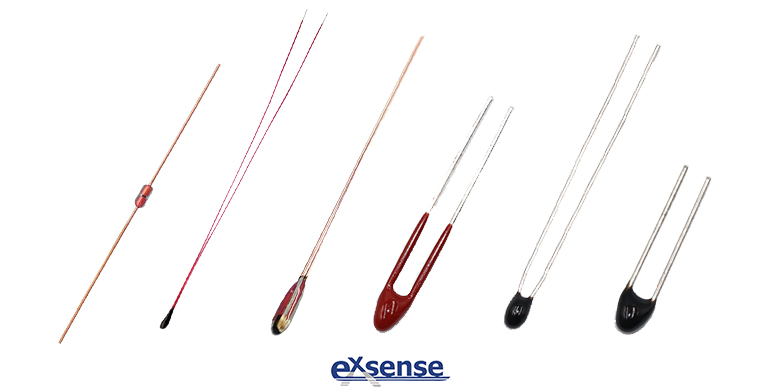
The resistance value of NTC thermistor depends to a large extent on the resistivity of the NTC ceramic material itself, the distance between the internal electrodes, etc., so that the required resistance value of the thermistor can be roughly determined at the pre-sinter stage. As a result, it’s difficult to adjust the resistance value after sintering, especially to reduce the resistance value. NTC ceramic materials usually take Mn as the main component. In the manufacturing process of NTC thermistor, when the ceramic raw materials are not sufficiently dispersed, the ceramic particles after sintering may not be evenly dispersed, and the resistance value of each thermistor may be deviated.
As a method to adjust the deviation of the resistance value of NTC thermistor, the resistance value can be adjusted after sintering by adjusting the distance of the covering part of the external electrode formed at both ends of the ceramic body (the part extending from the end face of the ceramic body to the side part). However, although this method can make small adjustment to the resistance value, it is difficult to make large adjustment. In addition, with the miniaturization and low resistivity of the NTC thermistor, the practice of setting the resistance value of ceramic body to be lower than the target value in advance has great limitations. In order to suppress the resistance value deviation between NTC thermistors, the most ideal method is to reduce the resistance value after sintering.
In order to solve the above problems, EXSENSE Electronics introduce a ceramic material of NTC thermistor, which can adjust the resistance value after sintering. This kind of ceramic material forms the first phase of Mn as the parent phase in the sintering process; If the sintering temperature drops below the specified temperature, the second phase with different crystal structure from the first phase (the second phase has higher resistance than the first phase) will precipitate out. It also shows that when the sintering temperature is above the specified temperature, the second phase with high resistance can form a crystalline structure with the first phase and disappear. The specific manufacturing method of this NTC thermistor ceramic material is as follows:
First, the contents of Mn, Ni and Cu after sintering are calculated by atomic ratio, and MnO, NiO and CuO are weighed and mixed according to the ratio of Mn/Ni/Cu = 80.1/8.9/11.0 (Mn/Ni = 90/10). Then, polycarboxylate ammonium salt and pure water as dispersing agent are added to the mixture and put into a ball mill for several hours of wet mixing to crush it.
Second, after the mixed powder is dried, it was presintered for 2 hours at 800℃ to obtain ceramic powder. After that, dispersing agent and pure water are added to the ceramic powder again, and wet mixing is carried out for several hours in the ball mill to crush it. Ceramic slurry is prepared by adding acrylic resin, plasticizer, wetting agent and antifoaming agent, which are used as the water system binder resin, into the mixed powder, and the antifoaming treatment was carried out under the low vacuum pressure of 6.65*10~1.33*10Pa (500~1000mmHg). By the polyethylene terephthalate film carrier of membrane formation, using the method of blade coating after the forming of the ceramic slurry, than dried, thus, the thickness of ceramic substrate is 20~50μm is obtained. After cutting the obtained ceramic substrate into the specified size, laminated ceramic substrates with a specified number, then the ceramic substrate are pressed with the pressure of about 10Pa to obtain the laminated shape.
Third, The laminated shape was cut into a specified shape, and heated at 500℃ in the atmosphere for 1 hour to remove the binder, then kept at the highest sintering temperature of 1100℃ in the atmosphere for 2 hours. The sintering process includes heating up, maintaining high temperature and cooling down. In the process of heating up, after the removal of binder, the heating rate of 200℃/hour is reached to the highest sintering temperature of 1100℃. Then during the high temperature holding process, the temperature is kept at 1100℃ for 2 hours. Then, 1100℃~800℃ is set as the first cooling process, and less than 800℃ as the second cooling process. The cooling speed of the first cooling process is set as 200℃/hour, and the cooling speed of the second cooling process is set as 100℃/hour, thus the ceramic body is obtained.
The NTC thermistors made of this kind of NTC thermal ceramic material, even though they are micro-miniaturized and low in resistance, which can restrain the resistance deviation between products as much as possible. In addition, due to the area of applying heat is formed in a linear manner parallel to the external electrode on the surface of the ceramic body, the area of applying heat presents low resistivity. The resistance value can be changed simply by adjusting the number of bars of the area of applying heat formed parallel to the external electrode, and the resistance value can also be slightly modified.



